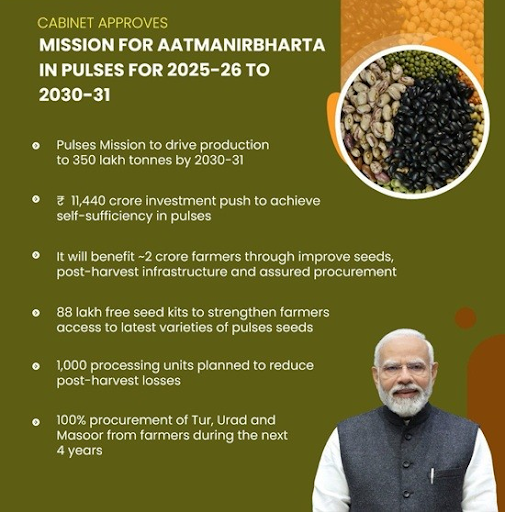Context:
Recently, the Union Cabinet, chaired by the Prime Minister, accorded approval to a new mission aiming to make India self‑reliant in pulses, named the Mission for Aatmanirbharta in Pulses.
Key Features & Components of the Mission:
The mission is to be implemented during 2025‑26 to 2030‑31, with a total outlay of ₹ 11,440 crore.
|
Component |
Description |
|
Targets |
Production to be raised to 350 lakh tonnes by 2030‑31; area under pulses expanded to 310 lakh hectares; yield to increase to 1,130 kg/ha. |
|
Seed & Variety Support |
Distribution of 126 lakh quintals of certified seeds over mission life; 88 lakh free seed kits to farmers, monitoring via SATHI portal (Seed Authentication, Traceability & Holistic Inventory). |
|
Area Expansion & Cropping Strategy |
Targeting rice fallow lands and promoting intercropping and diversification to bring 35 lakh additional hectares under pulses. |
|
Procurement & Price Support |
100 % procurement of Tur, Urad, and Masoor (lentil) at MSP via government agencies (NAFED, NCCF) for 4 years, under the Price Support Scheme of PM‑AASHA. |
|
Post‑Harvest & Value Chain |
Establish 1,000 processing & packaging units (with subsidy up to ₹ 25 lakh per unit) to reduce losses and add value. |
|
Cluster Approach & Targeted Districts |
Implementation through a cluster-based model in 416 focus districts. |
|
Capacity Building & Convergence |
Trainings, demonstrations (through ICAR, KVKs, state agencies). Convergence with existing schemes like Soil Health, Mechanisation, Plant Protection, etc. |
Significance & Impacts:
Food & Nutritional Security
· Increased pulse availability improves protein and micronutrient access, especially for vulnerable groups.
· Reduces reliance on imports, shielding domestic markets from global shocks.
Farmer Welfare & Income
· Assured procurement and MSP reduce risks, encouraging pulse cultivation.
· Value addition boosts income and rural employment.
Economic & External Sector
· Cuts import bills, saving foreign exchange.
· Stabilizes prices, curbing inflationary pressures.
Environmental & Agro-ecological
· Pulses enrich soil through nitrogen fixation, lowering fertilizer use.
· Enhances land use via intercropping and use of rice fallows, improving climate resilience.
Strategic & Policy
· Supports self-reliance (Aatmanirbharta) in agriculture.
· Strengthens infrastructure and institutions for long-term resilience.
Pulses in the Indian:
-
- Pulses are a vital source of plant-based protein, micronutrients, and dietary fibre in Indian diets.
- India is both the world’s largest producer and largest consumer of pulses.
- However, domestic production has lagged behind growing demand, causing India to import pulses (especially pigeon pea, lentil, etc.) to fill the gap.
- Import dependence has been estimated at around 15–20 % in recent years.
- Pulses are a vital source of plant-based protein, micronutrients, and dietary fibre in Indian diets.
Conclusion
The approval of the Mission for Aatmanirbharta in Pulses marks a watershed moment in India’s agricultural policy. It is ambitious in scope, well-aligned with national goals of food security, farmer prosperity, and self-reliance. If executed with rigor, state cooperation, and adaptive management, it could transform the pulses sector — shifting India from import dependence to sustained surplus.







